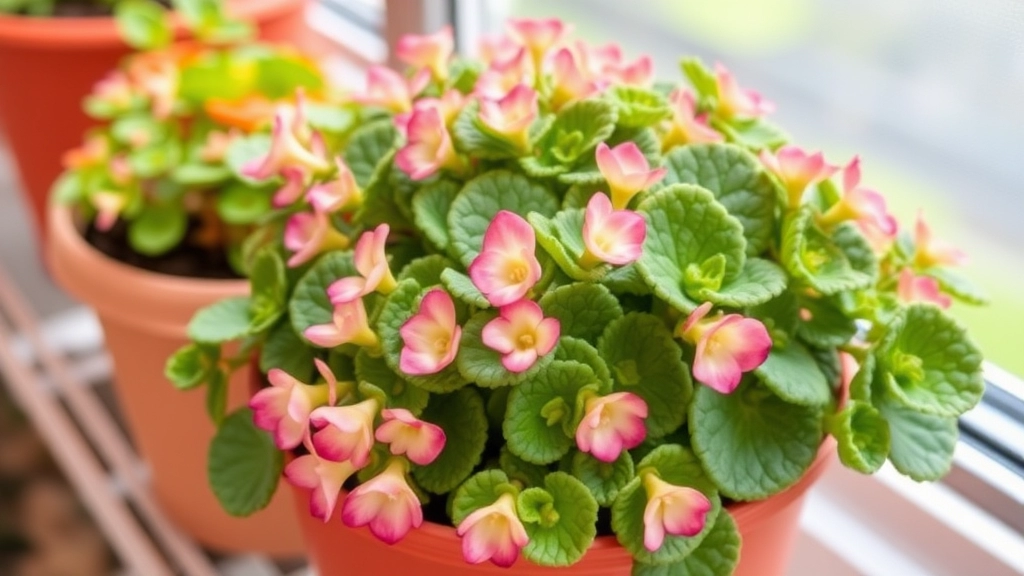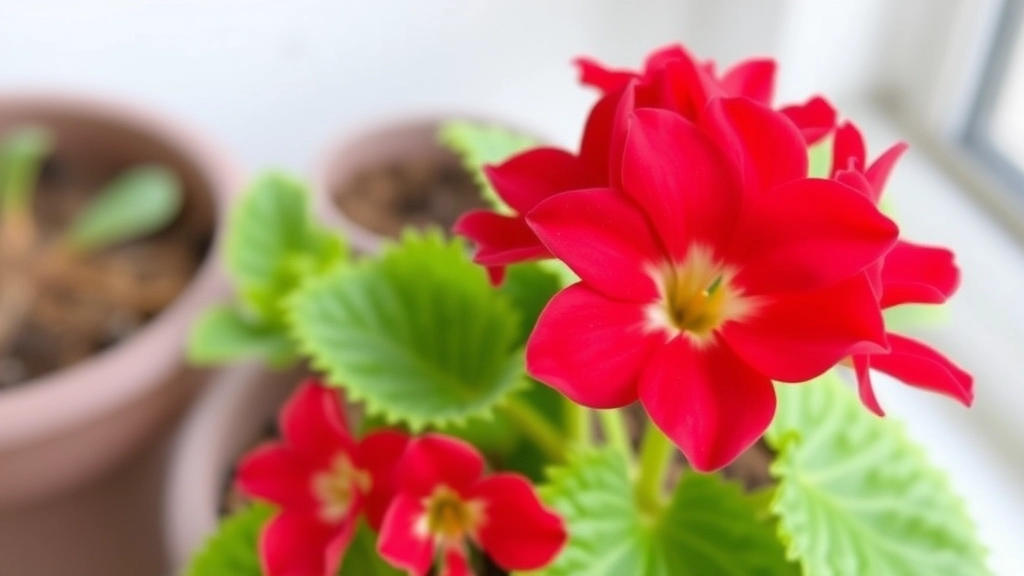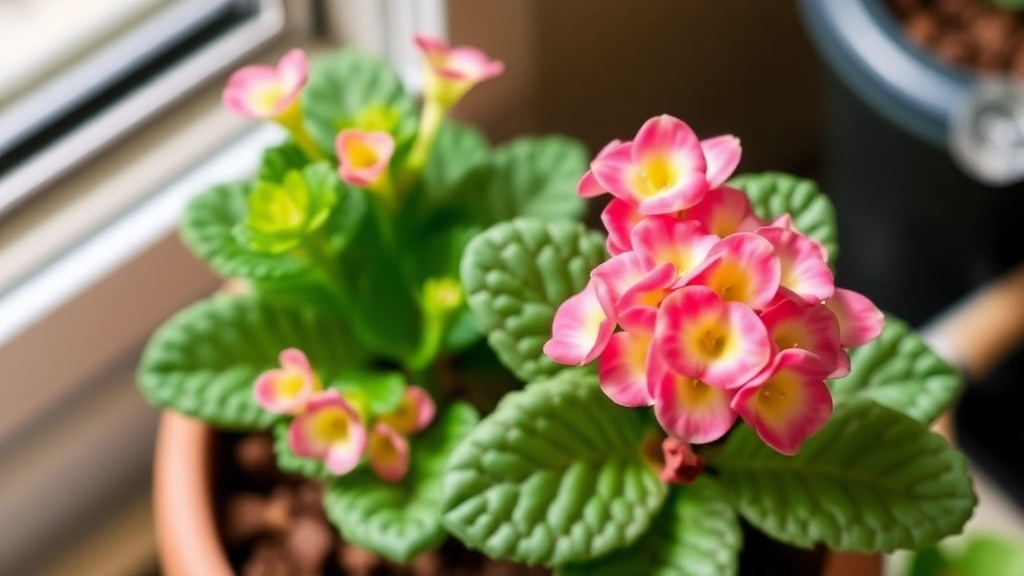Can Kalanchoe Grow Indoors?
Ever wondered, “Can Kalanchoe grow indoors?” Well, you’re in luck because I’m here to share my personal experience with this vibrant plant. Kalanchoe is a fantastic choice for indoor gardening, thanks to its low maintenance and stunning blooms. I’ve found that with the right care, it can thrive beautifully inside your home.
Getting Started
To get started, place your Kalanchoe in a spot with plenty of indirect sunlight. Water it sparingly, letting the soil dry out between waterings. Trust me, overwatering is a common mistake. With these simple tips, you’ll enjoy a healthy, blooming Kalanchoe that brightens up any room.
Benefits of Growing Kalanchoe Indoors
Are you considering adding some greenery to your indoor space?
Kalanchoe, a vibrant and resilient succulent, offers numerous benefits that can enhance your home environment.
Aesthetic Appeal
One of the most immediate advantages of growing Kalanchoe indoors is its stunning appearance.
- Variety of Colours: Kalanchoe comes in various colours, from bright reds to soft pinks and yellows, adding a splash of vibrancy to any room.
- Unique Foliage: Its thick, glossy leaves provide texture and interest, making it a perfect addition to your décor.
Air Quality Improvement
Did you know that indoor plants can improve air quality?
Kalanchoe contributes by:
- Absorbing Toxins: Like many succulents, it helps filter harmful pollutants from the air.
- Increasing Humidity: By releasing moisture, it can create a more comfortable indoor environment.
Low Maintenance
For those who may not have a green thumb, Kalanchoe is an excellent choice due to its low maintenance requirements.
- Drought Tolerance: This succulent requires less frequent watering, making it ideal for busy individuals.
- Resilience: Kalanchoe can thrive in various conditions, adapting well to indoor environments.
Health Benefits
Beyond aesthetics, Kalanchoe can positively impact your well-being.
- Stress Reduction: Studies suggest that having plants indoors can reduce stress and promote relaxation.
- Mood Enhancement: The presence of greenery can uplift your spirits and create a more inviting atmosphere.
If you’re looking for a comprehensive guide on how to care for your Kalanchoe, check out our expert tips to ensure your plant thrives. Additionally, for those interested in propagation, our step-by-step guide on propagating Kalanchoe in water is a must-read!
Ideal Indoor Conditions for Kalanchoe

So, you’re keen on growing Kalanchoe indoors? That’s fantastic! But before you dive in, let’s chat about the ideal indoor conditions that will help your plant thrive.
Temperature
Kalanchoe loves warmth. Aim for a temperature range of 20°C to 25°C during the day.
- Nighttime: Keep it slightly cooler, around 15°C to 18°C.
Avoid chilly drafts or sudden temperature drops, as Kalanchoe can be a bit fussy about that.
Humidity
Kalanchoe isn’t a fan of high humidity.
- Ideal Humidity Level: Around 40% to 50% is perfect.
If your home is on the humid side, consider using a dehumidifier or placing your plant in a well-ventilated area.
Air Circulation
Good airflow is crucial.
- Tip: Position your Kalanchoe near a window, but not in direct drafts.
This helps prevent issues like mold or pests.
Fertilizer
Feeding your Kalanchoe is key to vibrant growth.
- Frequency: Fertilize every 4-6 weeks during the growing season (spring and summer).
Use a balanced, water-soluble fertilizer diluted to half strength.
Light Requirements for Indoor Kalanchoe
When it comes to growing Kalanchoe indoors, one common concern is ensuring they receive the right amount of light. Without adequate light, these vibrant plants can become leggy and fail to bloom.
Understanding Light Needs
Kalanchoe thrives in bright, indirect sunlight. Here’s what you need to know:
- Direct Sunlight: While Kalanchoe can tolerate some direct sunlight, too much can scorch the leaves. Aim for a balance.
- Indirect Light: Placing your Kalanchoe near a window that receives filtered light is ideal. A south or east-facing window often works best.
- Duration: Kalanchoe typically needs around 6 hours of light per day. If natural light is limited, consider using grow lights to supplement.
Signs of Inadequate Light
Keep an eye out for these signs that your Kalanchoe may not be getting enough light:
- Leggy Growth: Stretched stems indicate the plant is reaching for light.
- Pale Leaves: A loss of vibrant colour can signal insufficient sunlight.
- Reduced Blooming: If your Kalanchoe isn’t flowering, it may need more light.
Tips for Optimal Light Exposure
To ensure your Kalanchoe thrives, consider these practical tips:
- Rotate the Plant: Every few weeks, rotate your Kalanchoe to ensure all sides receive equal light.
- Clean the Window: Dust and grime can block light, so keep your windows clean.
- Monitor Seasonal Changes: As seasons change, so does the intensity and duration of sunlight. Adjust your plant’s position accordingly.
For more detailed care tips, check out our guide on Kalanchoe lighting tips and our troubleshooting guide for non-flowering Kalanchoe.
Watering Schedule for Indoor Kalanchoe

One of the most common concerns for indoor gardeners is understanding the proper watering schedule for their plants. Kalanchoe, with its succulent leaves, has specific needs that differ from other houseplants.
Understanding Kalanchoe’s Water Needs
Kalanchoe thrives in well-draining soil and prefers to dry out between waterings. Overwatering is a frequent mistake that can lead to root rot. To keep your Kalanchoe healthy, consider the following tips:
- Check the Soil: Before watering, stick your finger about an inch into the soil. If it feels dry, it’s time to water.
- Water Thoroughly: When you do water, ensure that water seeps out of the drainage holes at the bottom of the pot. This ensures that the roots are adequately hydrated.
- Frequency: During the growing season (spring and summer), water your Kalanchoe every 2-3 weeks. In the winter months, reduce watering to once a month or even less, as the plant enters a dormant phase.
Signs of Overwatering and Underwatering
It’s crucial to recognise the signs of both overwatering and underwatering:
- Overwatering Symptoms:
- Yellowing leaves
- Mushy stems
- A foul smell from the soil
- Underwatering Symptoms:
- Droopy leaves
- Wrinkled or shrivelled appearance
- Leaves falling off
Tips for Effective Watering
- Use Room Temperature Water: Cold water can shock the plant.
- Water in the Morning: This allows the plant to absorb moisture before the heat of the day.
- Consider Humidity: Kalanchoe prefers drier air, so avoid placing it in overly humid environments.
Choosing the Right Pot and Soil
When it comes to growing Kalanchoe indoors, selecting the right pot and soil is crucial for its health and growth. You might wonder, âWhat type of pot should I use?â or âIs my soil suitable for Kalanchoe?â Let’s address these concerns.
Choosing the Right Pot
- Material: Opt for pots made of terracotta or ceramic. These materials allow for better airflow and drainage, which is essential for succulents like Kalanchoe.
- Size: A pot that is about 2-3 inches larger in diameter than the root ball is ideal. This provides enough space for growth without retaining excess moisture.
- Drainage Holes: Ensure your pot has drainage holes. This prevents water from accumulating at the bottom, which can lead to root rot.
Selecting the Right Soil
- Well-Draining Mix: Kalanchoe thrives in well-draining soil. Look for a potting mix specifically formulated for succulents or cacti.
- DIY Option: If you prefer to mix your own soil, combine:
- 2 parts potting soil
- 1 part coarse sand
- 1 part perlite or pumice
- pH Level: Aim for a slightly acidic to neutral pH (around 6.0 to 7.0) to ensure optimal growth.
By choosing the right pot and soil, you set the stage for a thriving Kalanchoe. For more detailed guidance, you might want to check out our best soil for Kalanchoe Blossfeldiana care tips and our comprehensive Kalanchoe plant care guide.
Common Indoor Pests and Diseases

So, you’ve got your Kalanchoe thriving indoors, but what happens when those pesky pests or diseases come knocking?
Worries You Might Face:
- Yellowing leaves?
- Sticky residue on your plants?
- Little bugs scuttling around?
Don’t worry; it’s more common than you think. Here’s a quick rundown of the usual suspects and how to tackle them.
Common Pests
- Mealybugs
- Look for white, cottony spots on your Kalanchoe.
- They suck the sap, causing stress to the plant.
- Aphids
- Tiny green or black bugs that cluster on new growth.
- They can distort leaves and stunt growth.
- Spider Mites
- Tiny, almost invisible, and often leave webbing.
- They thrive in dry conditions and can cause leaf discoloration.
- Scale Insects
- Brown, hard bumps on stems and leaves.
- They also suck sap and can weaken your plant.
Common Diseases
- Root Rot
- Caused by overwatering, leading to mushy roots.
- Look for wilting leaves despite wet soil.
- Powdery Mildew
- White, powdery spots on leaves.
- Often appears in high humidity and poor air circulation.
How to Combat These Issues
- Regular Checks: Inspect your Kalanchoe weekly. Catching problems early makes a big difference.
- Natural Remedies:
- For pests, try neem oil or insecticidal soap.
- For diseases, ensure good airflow and avoid excess moisture.
- Isolation: If you spot a problem, isolate the affected plant to prevent spreading.
As we delve deeper into caring for your indoor Kalanchoe, pruning and maintenance play a pivotal role in keeping your plant healthy and vibrant.
### Why Pruning Matters
Have you noticed your Kalanchoe becoming leggy or overcrowded? Pruning is essential for promoting bushier growth and ensuring your plant receives adequate light. It also helps prevent diseases by improving air circulation.
### When to Prune
– **Timing**: The best time to prune your Kalanchoe is during its active growing season, typically in spring or early summer.
– **Signs to Prune**: Look for:
– Wilted or yellowing leaves
– Overgrown stems
– Spent flowers
### How to Prune
1. **Use Clean Tools**: Always use sterilised scissors or pruning shears to prevent infections.
2. **Cut at the Right Spot**: Trim back stems just above a leaf node to encourage new growth.
3. **Remove Dead Leaves**: Snip away any dead or discoloured leaves to keep your plant looking its best.
### Maintenance Tips
– **Dusting**: Regularly wipe the leaves with a damp cloth to remove dust. This enhances photosynthesis.
– **Fertilising**: Feed your Kalanchoe with a balanced fertiliser every 4-6 weeks during the growing season.
– **Repotting**: Consider repotting every couple of years to refresh the soil and provide more room for growth. For more detailed guidance, check out this [complete guide to kalanchoe plant care](https://planthq.org/complete-guide-to-kalanchoe-plant-care/).
If you’re dealing with specific issues like yellowing leaves, you might find this article on [why Kalanchoe leaves turn red](https://planthq.org/why-are-my-kalanchoe-leaves-turning-red/) particularly helpful.
Propagating Kalanchoe Indoors
So, you’ve got a thriving Kalanchoe and you’re thinking, “How can I grow more of these beauties?”
Great question! Propagating Kalanchoe indoors is not only easy but also super rewarding.
FAQs about Growing Kalanchoe Indoors
Can Kalanchoe grow indoors?
Yes, Kalanchoe can thrive indoors if provided with the right conditions. It’s important to manage temperature, humidity, and watering carefully to ensure healthy growth.
What is the ideal temperature for indoor Kalanchoe?
Kalanchoe prefers a daytime temperature range of 20°C to 25°C and a nighttime range of 15°C to 18°C. Avoid sudden temperature drops and chilly drafts.
How much humidity does Kalanchoe need?
Kalanchoe thrives in a humidity level of about 40% to 50%. If your home is too humid, consider using a dehumidifier or placing the plant in a well-ventilated area.
How often should I fertilize my indoor Kalanchoe?
Fertilize your Kalanchoe every 4-6 weeks during the growing season (spring and summer) using a balanced, water-soluble fertilizer diluted to half strength.
What is the proper watering schedule for Kalanchoe?
During the growing season, water your Kalanchoe every 2-3 weeks. In the winter months, reduce watering to once a month or less. Ensure the soil dries out between waterings to prevent root rot.
How can I tell if my Kalanchoe is overwatered or underwatered?
Signs of overwatering include yellowing leaves, mushy stems, and a foul smell from the soil. Underwatering symptoms include droopy leaves, a wrinkled or shriveled appearance, and leaves falling off.
What are common pests that affect indoor Kalanchoe?
Common pests include:
- Mealybugs: White, cottony spots on the plant.
- Aphids: Tiny green or black bugs clustering on new growth.
- Spider Mites: Tiny, almost invisible pests that leave webbing.
- Scale Insects: Brown, hard bumps on stems and leaves.
What diseases commonly affect indoor Kalanchoe?
Common diseases include:
- Root Rot: Caused by overwatering, leading to mushy roots and wilting leaves despite wet soil.
- Powdery Mildew: White, powdery spots on leaves, often appearing in high humidity and poor air circulation.
How can I prevent and treat pests and diseases on my Kalanchoe?
To combat pests and diseases:
- Regular Checks: Inspect your Kalanchoe weekly to catch problems early.
- Natural Remedies: Use neem oil or insecticidal soap for pests and ensure good airflow and avoid excess moisture for diseases.
- Isolation: Isolate affected plants to prevent spreading issues to other plants.
References
-
Kalanchoe Plant Care: How To Grow A Kalanchoe
-
How to Grow and Care for Kalanchoe
-
Kalanchoe: How to Grow and Care for Kalanchoe Plants
